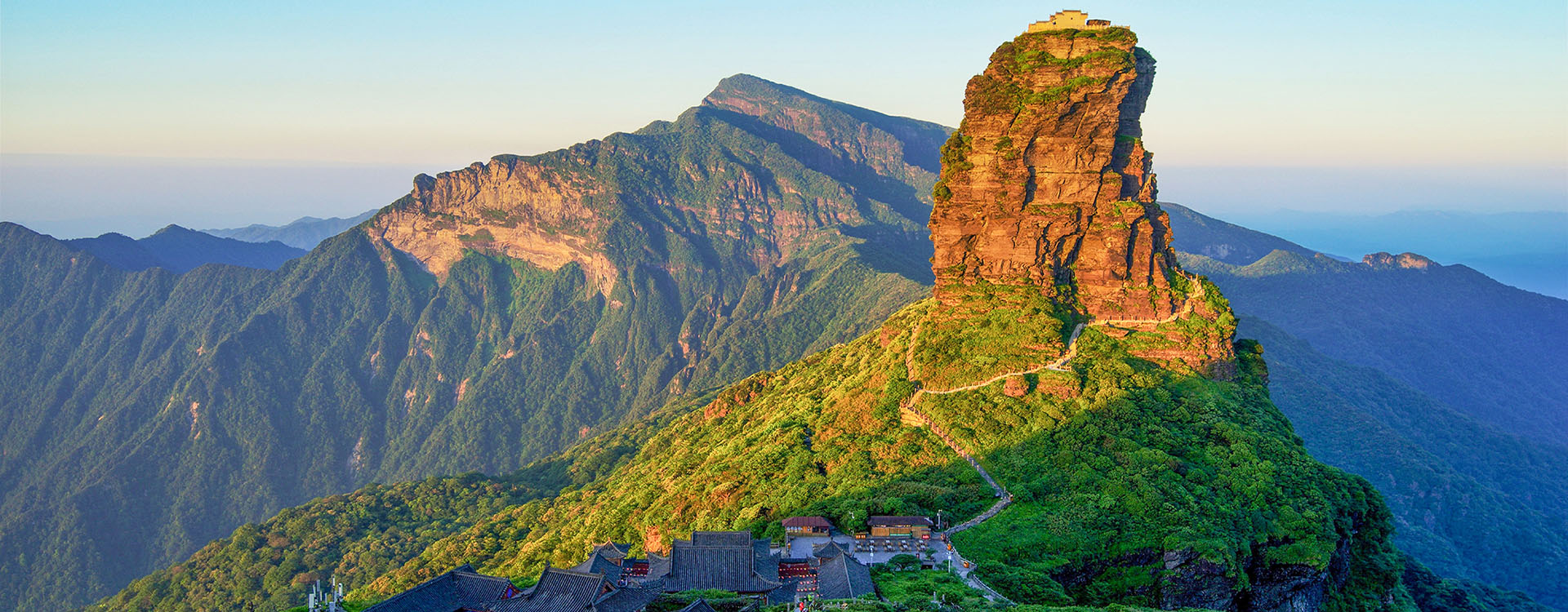Overview
Tongren, located in the northeastern part of Guizhou Province, is a city rich in natural beauty and cultural heritage. With its unique geographical location bordering Hunan and Chongqing, it serves as a gateway to Guizhou, attracting tourists with its distinct charm.
1. Natural Attractions
1.1 Fanjing Mountain
World - Heritage Site and Natural Wonder: Fanjing Mountain is a world - natural - heritage site and a 5A - level national scenic area. Rising majestically, it features breathtaking karst landscapes, with towering peaks, deep valleys, and strange - shaped rocks. The famous Mushroom Rock, balancing precariously for thousands of years, is a symbol of the mountain.
Rich Biodiversity: It is a biodiversity hotspot, home to numerous rare and endangered species. The golden - haired monkey, a first - class protected animal in China, inhabits the lush forests here. The mountain is also covered with a wide variety of plants, making it a paradise for nature lovers and botanists.
1.2 Tongren Grand Canyon
Spectacular Canyon Scenery: Tongren Grand Canyon offers a magnificent view of deep gorges, dense forests, and cascading waterfalls. The clear streams meander through the canyon, creating a harmonious symphony of nature. The vertical cliffs on both sides of the canyon give visitors a sense of the power and grandeur of nature.
Outdoor Recreation Opportunities: For adventure enthusiasts, the canyon provides opportunities for activities such as hiking, rock climbing, and river tracing. The well - developed trails allow tourists to explore the hidden corners of the canyon and get close to nature.
1.3 Yamugou Scenic Area
Natural Retreat: Yamugou Scenic Area is a haven of peace and tranquility. The area is characterized by its fresh air, crystal - clear water, and lush greenery. The ancient trees and bamboo forests create a serene environment, making it an ideal place for tourists to escape the hustle and bustle of city life.
Cultural Elements: In addition to its natural beauty, the area also has some cultural elements. Local ethnic minority villages are scattered around the scenic area, where visitors can experience the unique customs and traditions of the ethnic groups.
2. Cultural Attractions
2.1 Zhongnanmen Historical and Cultural Tourism Area
Historical Significance: Also known as Tongren Ancient City, it was built in 1413. As the seat of the prefectural government since the Ming Dynasty, it has a history of over 600 years. The well - preserved ancient buildings, including traditional houses, temples, and city gates, reflect the architectural style and urban layout of that era.
Cultural Heritage: Walking along the ancient streets, visitors can feel the strong historical atmosphere. There are also many cultural relics and intangible cultural heritage items on display, such as traditional handicrafts, folk art performances, which showcase the long - standing history and rich culture of Tongren.
2.2 Daming Biancheng (Ming Dynasty Border City)
Ming - Dynasty - Themed Experience: This scenic area is themed around the Ming Dynasty. The architecture, costumes, and cultural activities all recreate the charm of the Ming Dynasty. Tourists can participate in various activities, such as archery, calligraphy, and traditional festivals, to experience the lifestyle and culture of that time.
Historical Exhibits: There are also many historical exhibits in the scenic area, introducing the history, economy, and military of the Ming Dynasty, providing visitors with a deeper understanding of this important period in Chinese history.
2.3 Cinnabar Ancient Town
Unique Cinnabar Culture: Located in Wanshan District, the town is famous for its long - standing cinnabar mining and processing history. Cinnabar, with its bright red color, has not only been used in traditional Chinese medicine but also in cultural and religious ceremonies. The town preserves many historical sites related to cinnabar mining, such as ancient mines and processing workshops.
Industrial Heritage Tourism: It has transformed into an industrial heritage tourism destination. Tourists can visit the mines, learn about the mining process, and see the unique cinnabar - related handicrafts, experiencing the unique industrial culture of the region.
3. Ethnic Minority Culture
Rich Ethnic Diversity: Tongren is home to 29 ethnic groups, including the Miao, Dong, Tujia, and Gelao ethnic minorities. Each ethnic group has its own unique traditions, festivals, and art forms.
Festivals and Customs: The festivals of these ethnic groups are colorful and full of vitality. For example, the Miao people's April 8th Festival, the Dong people's Dong New Year, and the Tujia people's New Year - Eve - Ahead - of - Time Festival are all important traditional festivals. During these festivals, there are various activities such as singing, dancing, and traditional sports competitions, attracting a large number of tourists to participate and experience.




